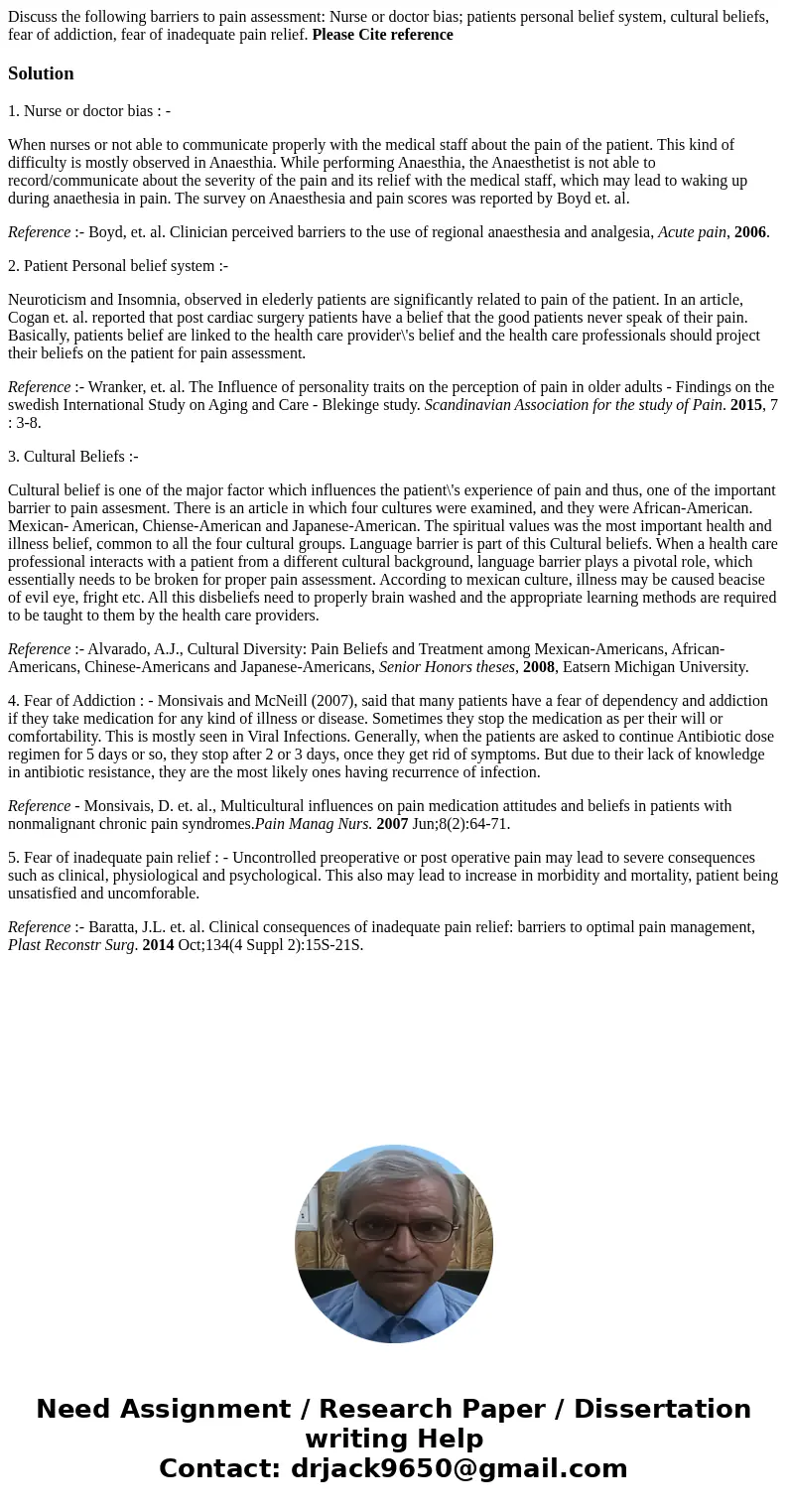Discuss the following barriers to pain assessment Nurse or d
Discuss the following barriers to pain assessment: Nurse or doctor bias; patients personal belief system, cultural beliefs, fear of addiction, fear of inadequate pain relief. Please Cite reference
Solution
1. Nurse or doctor bias : -
When nurses or not able to communicate properly with the medical staff about the pain of the patient. This kind of difficulty is mostly observed in Anaesthia. While performing Anaesthia, the Anaesthetist is not able to record/communicate about the severity of the pain and its relief with the medical staff, which may lead to waking up during anaethesia in pain. The survey on Anaesthesia and pain scores was reported by Boyd et. al.
Reference :- Boyd, et. al. Clinician perceived barriers to the use of regional anaesthesia and analgesia, Acute pain, 2006.
2. Patient Personal belief system :-
Neuroticism and Insomnia, observed in elederly patients are significantly related to pain of the patient. In an article, Cogan et. al. reported that post cardiac surgery patients have a belief that the good patients never speak of their pain. Basically, patients belief are linked to the health care provider\'s belief and the health care professionals should project their beliefs on the patient for pain assessment.
Reference :- Wranker, et. al. The Influence of personality traits on the perception of pain in older adults - Findings on the swedish International Study on Aging and Care - Blekinge study. Scandinavian Association for the study of Pain. 2015, 7 : 3-8.
3. Cultural Beliefs :-
Cultural belief is one of the major factor which influences the patient\'s experience of pain and thus, one of the important barrier to pain assesment. There is an article in which four cultures were examined, and they were African-American. Mexican- American, Chiense-American and Japanese-American. The spiritual values was the most important health and illness belief, common to all the four cultural groups. Language barrier is part of this Cultural beliefs. When a health care professional interacts with a patient from a different cultural background, language barrier plays a pivotal role, which essentially needs to be broken for proper pain assessment. According to mexican culture, illness may be caused beacise of evil eye, fright etc. All this disbeliefs need to properly brain washed and the appropriate learning methods are required to be taught to them by the health care providers.
Reference :- Alvarado, A.J., Cultural Diversity: Pain Beliefs and Treatment among Mexican-Americans, African-Americans, Chinese-Americans and Japanese-Americans, Senior Honors theses, 2008, Eatsern Michigan University.
4. Fear of Addiction : - Monsivais and McNeill (2007), said that many patients have a fear of dependency and addiction if they take medication for any kind of illness or disease. Sometimes they stop the medication as per their will or comfortability. This is mostly seen in Viral Infections. Generally, when the patients are asked to continue Antibiotic dose regimen for 5 days or so, they stop after 2 or 3 days, once they get rid of symptoms. But due to their lack of knowledge in antibiotic resistance, they are the most likely ones having recurrence of infection.
Reference - Monsivais, D. et. al., Multicultural influences on pain medication attitudes and beliefs in patients with nonmalignant chronic pain syndromes.Pain Manag Nurs. 2007 Jun;8(2):64-71.
5. Fear of inadequate pain relief : - Uncontrolled preoperative or post operative pain may lead to severe consequences such as clinical, physiological and psychological. This also may lead to increase in morbidity and mortality, patient being unsatisfied and uncomforable.
Reference :- Baratta, J.L. et. al. Clinical consequences of inadequate pain relief: barriers to optimal pain management, Plast Reconstr Surg. 2014 Oct;134(4 Suppl 2):15S-21S.

 Homework Sourse
Homework Sourse